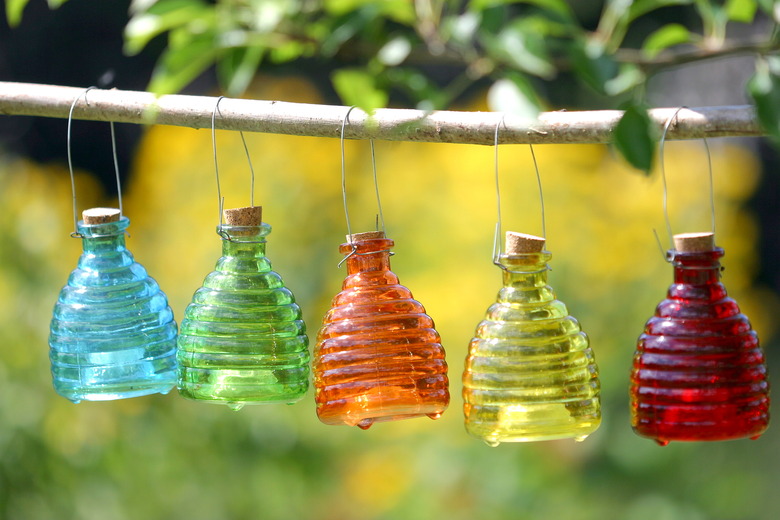What Is The Most Effective Liquid Bait For Wasp Traps?
We may receive a commission on purchases made from links.
Wasps are pollinators, and that means they qualify for beneficial insect status. However, given their painful stings, most people do not want wasps too close to their home or patio. A few close encounters with a wasp are guaranteed to put a damper on a barbecue in the backyard.
If you notice wasps hanging around the grill or find a wasp nest close to the house, your choices are limited. You can call in a pest professional to deal with the problem, exterminate the nest with a spray, or kill individual wasps in wasp traps. Wasp traps are neither expensive nor dangerous to use, so many people think traps are the best option. Before you make a decision, it helps to get an overview of the trap process, including when to put them out, where to site them, and what type of bait to use to lure in the wasps.
Tip
During the summer, the best liquid baits for wasp traps are sugary substances, such as fruit juice, sugar water, and sugary soft drinks.
Why Use Wasp Traps?
Why Use Wasp Traps?
Taking out wasp nests comes with built-in risks. Just as you would put up a fight if you found someone destroying your home, wasps have the same territorial instinct. Getting stung by one wasp is unpleasant, but getting attacked by a nest of wasps is much worse. That's why it can be considered safe to eliminate individual wasps with traps before they get around to nest building.
Wasp traps are not complicated. They are often nothing more than a box, bottle, or bag into which bait is placed. The bait must be some product that the wasp is attracted to. While the trap opening allows the wasps into the container, it prevents them from leaving. Unable to get out, the wasps drown in liquid in some traps or suffocate in others.
Selecting Bait for Traps
Selecting Bait for Traps
It is evident that a wasp trap will not be effective if the bait set out to attract the wasps is not sufficiently appealing to cause them to enter. Wasps enjoy many different types of foods and nectars, but not all will work for bait. While many wasp traps offer sugary liquids as bait, some people swear that bits of meat work far better. Both positions have some merit.
Wasps select their food according to the needs of their community. During spring, the wasps are busy propagating. During that time, they are looking for foods that are high in protein. Meat scraps fill the bill and are perhaps the best bait for early in the season. If you are using a trap that drowns the wasps, start with water and a little dish soap and then add grease from cooked meat.
As spring evolves into summer, however, the wasp's love of sugary things comes to the forefront. At that time, jams, jellies, fruits, fruit juices, sugar water, and sugary soft drinks all work well. You can often find this sugary type of bait in commerce.
Setting Up Traps
Setting Up Traps
It's easy to wait too long to set up wasp traps. Many people start to think about wasp issues in summer when the barbecue is cooking and the sun is warm. However, by that time, the wasps have already built their nests and settled in. No matter how effective wasp traps may be, they are not effective enough to take out an entire wasp community, and during the height of summer, hungry wasps have many other choices of food than whatever you use for bait, so attracting them to a trap is more difficult. You'll need to destroy the nest or call in a professional.
For traps to work, you have to set them up in spring before nests are established. The idea is to kill local wasps before they get set up in a thriving nest in your backyard or even your fireplace. There is less for them to eat in spring, so the bait is more likely to attract them.
Be thoughtful about selecting a trap location. Since you don't want wasps gathering near the picnic table or patio, don't put the baited traps there. Keep them at least 20 feet from areas where you and your family will gather outside. Ideally, hang the trap somewhere the wasps are already visiting, like in the branches of a spring-flowering fruit tree.
Maintaining the Traps
Maintaining the Traps
Since wasp traps can be made from inexpensive items, like plastic bottles, it is entirely acceptable to toss a trap when it is full of dead wasps. It is no surprise that some of the most popular commercially available traps are disposable. Clearing out dead wasps is not fun, but if you are up for it, check back often and clear out the traps regularly.
Of course, if you toss the used trap and build another, it saves you the worry of releasing a live wasp that will return to the nest to warn the others, and it makes it less likely that you will crush a dead wasp, causing a scent to be released that alerts other wasps of danger.
